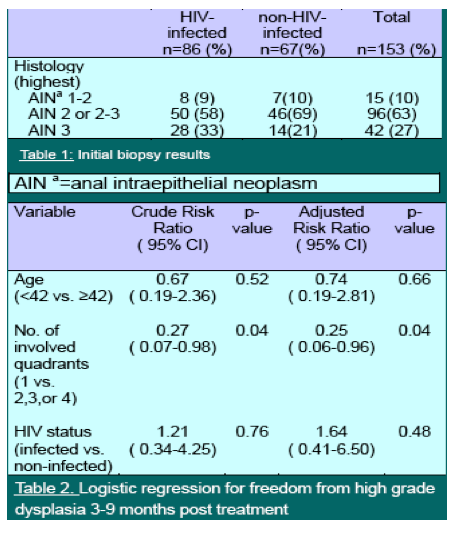 |
 |
 |
| |
Treatment of high grade anal lesions in high risk patients:
outcome at an urban community health center
|
| |
| |
Reported by Jules Levin
IDSA Oct 20-23 2011
Sabrina Assoumou,MD; Lori Panther, MD, MPH; Yang Feng MS, MPH; Rebecca Gelman, PhD;
Dana Fugelso, MD, MPH; and Kenneth Mayer, MD
Beth Israel Deaconess Medical Center, Fenway Health,
Dana-Farber Cancer Center, Harvard Medical School
BACKGROUND:
Human Papillomavirus (HPV) causes anal cancer. Humanimmunodeficiency(HIV)-infected patients and men who have sex with men (MSM) are at increased risk for developing anal dysplasia, a precursor to anal cancer.
OBJECTIVES:
To describe the outcome of treating biopsy-proven high grade anal dysplasia or carcinoma-in-situ (CIS) in HIV-infected and non-HIV-infected men who have sex with men (MSM) receiving primary care in a busy urban community setting.
METHODS:
A retrospective review of patients with biopsy-proven high grade anal dysplasia between 1996 and 2010 was performed. Only incident high grade lesions with documented follow-up internal exams were included. A logistic regression model included the following covariates: number of epithelial surface quadrants involved (1 vs. 2,3,or 4), age (<42 vs. age ≥42) and HIV status. The extent of disease was described by the number of quadrants involved.
RESULTS:
213 incident cases of high grade anal lesions were identified. 153 patients had treatment and met inclusion criteria; 86 (56%) were HIV-infected. Mean duration of HIV diagnosis was 11.7 years and median CD4 count 514/mm3 with a range of 21 to 1308 at the time of diagnosis. Treatments included either office-based ablation with a high frequency desiccator or intraoperative carbon dioxide laser destruction. Eighty patients (51%) were initially treated with ablation, 49(61%) returned for follow-up at least once between 3 and 9 months. Among those, 26 (53%) were free of high grade lesion, 19 (39%) had high grade disease; and 4 (8%) had unknown disease grading. Having only one quadrant involved at the time of treatment was significantly associated with a lower probability of high grade disease at follow-up (p-value 0.04; 65% of 26 patients with 1 quadrant and 36% of 22 patients with 2-4 quadrants were free of high grade disease.)

CONCLUSIONS/ IMPLICATIONS: Fifty three percent of patients were free of high grade disease within 9 months of an office-based procedure. Those with only one quadrant affected were more likely to be free of high grade disease. Further research is needed to evaluate the long term outcome of treating high grade disease in those at highest risk of developing anal cancer.
|
| |
|
 |
 |
|
|